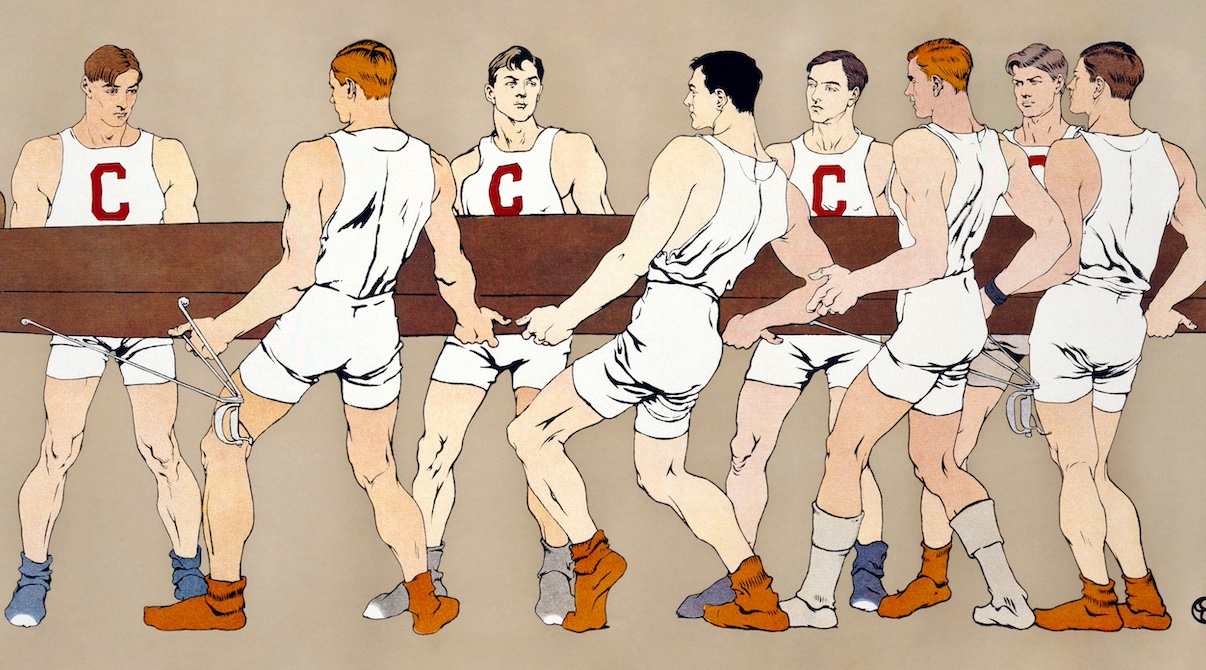In the introduction to her 2017 book Testosterone Rex: Unmaking the Myths of Our Gendered Minds, University of Melbourne Professor of History and Philosophy of Science Cordelia Fine writes: “Testosterone Rex is extinct. It misrepresents our past, present, and future; it misdirects scientific research; and it reinforces an unequal status quo. It’s time to say good-bye, and move on.”
“Testosterone Rex” is the name Fine gives to the “neat and compelling account of our societies’ persistent and seemingly intractable sex inequalities,” told by “weaving together interlinked claims about evolution, brains, hormones, and behaviour.” It’s the story of our evolutionary history in which sex differences in investments toward reproduction produce different strategies for reproductive success, leading to “promiscuous,” “risk-taking and competitive” men, and women “more focused on tending to their precious offspring than diverting their energy to chasing multiple lovers, riches, and glory.” It leads to our thinking that there are “not just two kinds of reproductive system, but two kinds of people.”
Despite devoting a whole book to the “unmaking” of this myth, Fine is clear-eyed about the prospects of its being put in the ground once and for all. “No doubt Testosterone Rex will survive the savaging it receives in this book, and—like a taxidermied family dog that persists past its natural life span—continue to linger on in the public and scientific imagination,” she writes.
This turns out to have been prescient. Biological anthropologist Carole Hooven is the taxidermist; and her 2021 book T: The Story of Testosterone, the Hormone That Dominates and Divides Us is the long-dead-but-still-familiarly-located-in-the-family-sitting-room taxidermied family dog. Here’s the final paragraph of Hooven’s book, referring to her son:
Because of the testosterone that he is on the way to producing, Griffin will likely differ from most women in many of the ways I’ve described in this book. Becoming a man is a beautiful thing. But—like every man—my son should enjoy his T responsibly.
Griffin’s testosterone will make him a man. A man is a different type of person than a woman, but a type not to be disparaged. Testosterone, like alcohol, is something that must be enjoyed responsibly. This is Testosterone Rex: testosterone-created human male sex difference, and not just physical difference, but behavioural difference.
As a work of popular science making parts of endocrinology and evolutionary theory accessible, Hooven’s T makes a solid contribution. As a political intervention against increasing pseudo-science about biological sex, reasserting that there are two sexes, male and female, and explaining what the existence of intersex conditions does and doesn’t mean, it is commendable. But as a defence of testosterone as a better or more central explanation of men’s behaviour than socialisation, it is utterly inadequate.
The Human Male
Hooven’s focus in the book is on what testosterone does across species, on the assumption that the human male is unlikely to be an exception: “The consensus of experts is that testosterone’s main job is to support the anatomy, physiology, and behaviour that increases a male’s reproductive output—at least in nonhuman animals. And men are no exception—T helps them reproduce, and directs energy to be used in ways that support competition for mates,” Hooven writes early in the book. Later, she asks, “T’s central role in male violence is well established for many nonhuman animals. Could men really be exceptions?”
She covers rats, lizards, chickens, birds, stags, chimpanzees, and humans. While the subtitle of the book suggests a more general division of the human into two types (“…the hormone that dominates and divides us”), she focuses on two specific topics in the book: physical violence and aggression and sexual promiscuity and libido. To keep things simple, we’ll just say “aggression and promiscuity” from now on. Behavioural differences between the sexes in aggression and/or promiscuity for each of these animals are explained, and how testosterone works to support these behaviours in the males of each species is detailed, sometimes alongside the reporting of ingenious testosterone-or-not (e.g. cutting off stags’ testicles) and testosterone-here-or-there (e.g. from testicles located outside the body or from testicles relocated to inside the abdomen) experiments.
If we ignore that humans are very unlike rats, lizards, chickens, birds, stags, and chimpanzees, then this can seem compelling: the males of all these species show behavioural differences from the females in aggression and promiscuity, and the males of all these species have higher testosterone than the females. The human male also shows behavioural differences from the human female in aggression and promiscuity, and he has higher testosterone than the female. Thus, testosterone must be the thing that explains human sex differences in these two areas. Or, at the very least, testosterone must be a large part of the explanation. Hooven writes, “The more I researched testosterone in humans and other animals, the more convinced I became that socialization is only part of the story. T, I have come to appreciate, plays a central role in human sex differences, and not just in physical traits” (emphasis added).
What About Socialization?
The rival hypothesis, named but not taken up in any detail in Hooven’s book, is that socialization explains these human sex differences. As she puts it, “If T is not to blame, the obvious alternative hypothesis is that the greater level of male aggression is largely due to socialization.” In the first chapter of her book, under the section heading “Uncomfortable Ideas,” Hooven names Fine as “one leader of this movement” —a movement to establish that “the gendered structure of human bodies, behaviour, and institutions floats almost completely free from biology (and in particular from testosterone),” and that “the theory that testosterone plays a central role in masculine behaviour is extinct, crushed to death by the weight of the evidence.” The books of other “T skeptic” feminist academics are named, including Gina Rippon’s 2019 The Gendered Brain, and Rebecca Jordan-Young and Katrina Karkazis’s 2019 Testosterone: An Unauthorized Biography. But remarkably, none of the ideas in these books are engaged with. In fact, Hooven devotes more words to discussing a review of Fine’s book in The Guardian than Fine’s book itself.
Needless to say, this is extremely strange. A number of well-established feminist academics challenged a prevailing orthodoxy about behavioural sex differences and what explains them. Perhaps those feminist academics went a little too far with their challenges, overcorrecting toward socialization in a way that needed to be rebalanced toward some particular mixture of socialization and testosterone. Perhaps the feminists were wrong about everything. No matter: what comes next has to be an engagement with their ideas to show what they are getting right or wrong. If an old position has received a set of compelling objections, then the only way to defend the original view is to respond persuasively to the objections. The debate cannot move forward based on a straightforward restatement of the original position. And yet that is exactly what Hooven’s book does.
The two hypotheses, socialization versus testosterone, are occasionally presented side by side in the book, for example as rival explanations of the exclusion of women in STEM, and in relation to girls with Congenital Adrenal Hyperplasia (CAH), who are more masculine in their play styles. On the latter, Hooven writes, “On the socialization view, it is a remarkable and unexplained coincidence that social forces have exactly reproduced the kinds of differences in play that would be predicted from endocrinology and evolution—in every human culture where they have been studied. The conclusion seems inescapable: as best we can tell, T makes boy brains.” Here we have the very strong claim that not only does testosterone create “boy brains” in boys, but that it also creates them in girls.
Humans Are Exceptional
Hooven asserts that men are not exceptions when it comes to testosterone and its effects. But human beings—and therefore men—are exceptional. We are extremely social and cooperative—like bees and ants, and unlike almost everything else. We are intelligent and self-aware—unlike almost everything else. We use tools—like some apes and some birds, and unlike almost everything else. We have culture, and religion, and morality, and ritual—unlike almost everything else. We have language—unlike everything else. That means human men are exceptional compared to most other male animals. As Fine puts it, quoting Greg Downey:
A broader understanding of human sexuality makes more visible the absurdity of “the tendency to argue that, in relation to sex, ‘human nature’ is what you get when you remove every human trait”. To understand human sexuality, you can’t simply “strip off everything that’s distinctively human, like language, social complexity, and self-awareness”, not to mention a person’s politics, economic situation, social norms, and social identities. These are inextricably part of each person’s sexuality.
Perhaps some counterfactual is true: if the apes had merely stood upright and lost some body hair but nothing else had changed, then testosterone would probably have the effects on those males that it has on other animals. But that’s a strange counterfactual to care about, given that its antecedent is false. Humans branched off from chimpanzees more than six million years ago, and as we’re sure any sane person would agree (and as Hooven acknowledges), we are quite different from them.
Testosterone as explanatorily central for behavioural differences between the sexes also faces other, awkward questions. Why is it that such a small percentage of men engage in violence and aggression? They’ve all got testosterone. Is the story supposed to be that testosterone is explanatorily central for only some men’s behaviours? But in that case, why some and not others? And why think that promiscuous or aggressive men’s behaviour was caused by testosterone, rather than by a lack of whatever it is that made the other men not behave promiscuously or aggressively? Socialization and culture re-emerge here as better explanations of what men do and don’t do.
This becomes even clearer when we think about an individual man—say, Jim the married Australian public servant who is having an affair with one of his co-workers. “What made Jim do it?” is hardly likely to be best answered by “his tens of thousands of years old evolutionary impulses to spread his seed.” We’re likely to get a much more satisfying and informative answer to why Jim does what he does by thinking about Jim’s upbringing; role-models; religious, cultural, and national values; personality traits; level of wealth; the quality of his marriage; and so on, than by thinking about what evolution has adapted the male to do for reproductive success. The same is true when our question is why Jim is more like this, and his wife more like that.
Rival Visions of Sexual Difference
Hooven appears to take the T-sceptic feminist position to be what is pejoratively known as the “blank slate” view, which is that humans come into the world with no pre-dispositions and pick up all their behaviour through socialisation (including through imitation and learning). On this view, there would be no effects of testosterone, and indeed no sex-differentiated effects at all. If we socialized the sexes in exactly the same way, the blank-slater would expect to see them become exactly the same as each other (in terms of their behaviour, not in terms of their bodies). If we’re not socializing men to aggression and promiscuity, then it’s mysterious why they are more aggressive and promiscuous. Against this view, Hooven is making the objection that we do in fact see some differences between the sexes that are plausibly accounted for by endocrinology (hormone differences), such as the CAH girls mentioned already.
But the feminist academics she names as opponents don’t hold the blank slate view; in fact, they explicitly reject it. Here’s Fine again: “while the genetic and hormonal components of sex certainly influence brain development and function—we are not asexual blank slates—sex is just one of many interacting factors. We are an adapted species of course, but also unusually adaptable.”
Once the blank slate view is set aside, two further views are possible. One we can call the “beasts in chains” view of men’s natures. On this view, all individual boys are born with a T-scaffolded disposition toward aggression and promiscuity, and it is the job of family members, educators, members of the community, etc. to socialise the boy—to chain the beast—so that his worst impulses are kept in check. This makes sense of Hooven’s claim that her son must “enjoy his T responsibly.”
The other we can call the “extreme plasticity” view of human nature, a view on which humans are incredibly malleable. Some versions of this view involve treating boys differently in a way that makes them different, and some involve treating boys and girls the same in a way that makes them the same. Humans are extremely plastic, having adapted to a huge range of different types of environmental and ecological conditions across the globe and throughout history. So the only question for this view is what the limits are. Are there some sex-differentiated human dispositions that would manifest in sex-differentiated behaviour no matter the social conditions?
We can use an example from Hooven to illustrate the difference between these two views. In the chapter titled “Violent Men,” she notes that
Singapore’s young men don’t tend to get drunk—in public, anyway. Public drunkenness is a serious offence… The rate of violent crime in Singapore is miniscule compared to Jamaica, the United States, or even relatively peaceful Canada, whose assault rate is about fifty times greater than Singapore’s. Singapore has the lowest murder rate in the world, alongside Japan. Why is Singapore so different? The government doesn’t pump pacifying chemicals into the water supply. The explanation presumably lies in the Singaporean culture, which is one of law-abidingness, strict discipline in families, and lack of poverty, plus harsh criminal penalties, among other factors.
On the “beasts in chains” view, Singapore has very effective chains. (And note a prediction of this view, which is that were the chains to come off, the beasts would re-emerge). On the “extreme plasticity” view, Singapore socializes its citizens in a particular way, and by doing so it makes them that way. (This is a point that feminists have long observed about women: that socialization into femininity creates feminine women).
Are either of these views Hooven’s? There are occasional acknowledgements, throughout the book, of the role of socialization. She says “…behaviours that show sex differences are often heavily influenced by culture—and aggression is a clear example;” and later “Laws and cultural and social norms can push physical aggression up or down.” This might suggest an openness to at least some plasticity.
But compare these other comments. For one, “I have suggested throughout this book that socialization does not fare well against its evolutionary T-based rivals.” Or for another, “It is within our power to close or widen sex differences in aggression—but the underlying tendencies producing those differences precede culture, and they exist because of testosterone” (emphasis added). The book is called “T.” Every chapter is about testosterone and the behaviours it causes. Hooven appears to hold the “beasts in chains” view, which limits the role of socialisation to “chains.” (Fine, in contrast, appears to hold the “extreme plasticity” view, which makes testosterone one relatively minor factor among a great many in producing human male behaviour, and which might be fully neutralized by one or more of the many other complicated factors that there are—Chapter 4 of Testosterone Rex has a detailed discussion of this idea.)
If Hooven’s view was merely that feminist scientists had gotten the balance wrong between testosterone and socialization as respective causes of male behaviour, she would have written a different book—not one focused on testosterone, but one taking both testosterone and socialization seriously and attempting to defend a particular view about the contributions of each. Without engaging the arguments and evidence of the feminist scientists who have objected to T-centrism, she has merely reasserted the old “Testosterone Rex” and failed to advance the debate.




